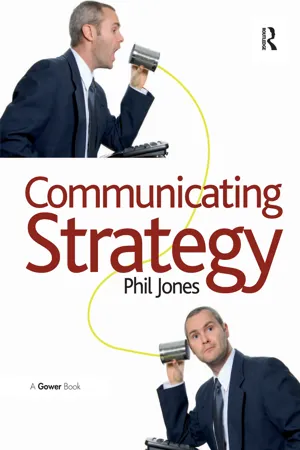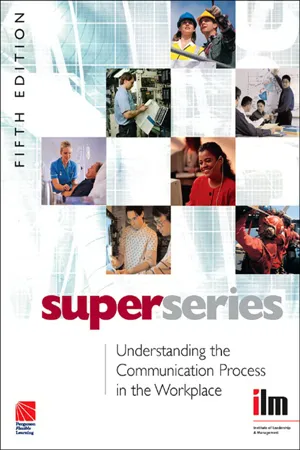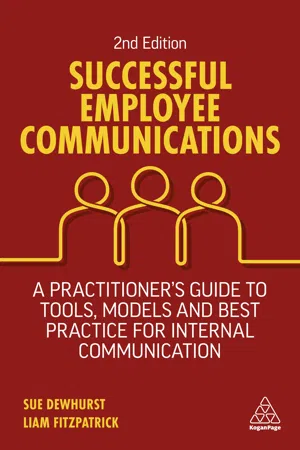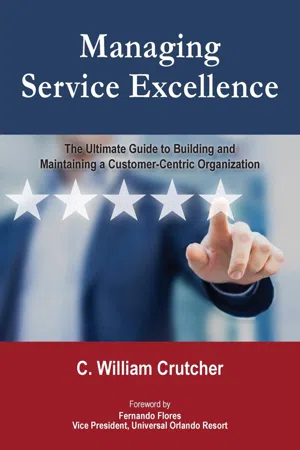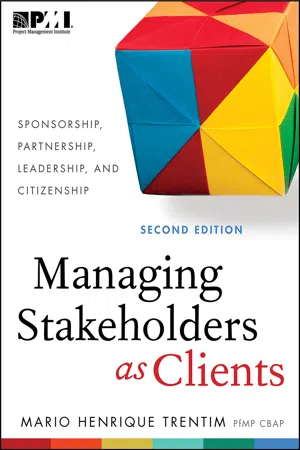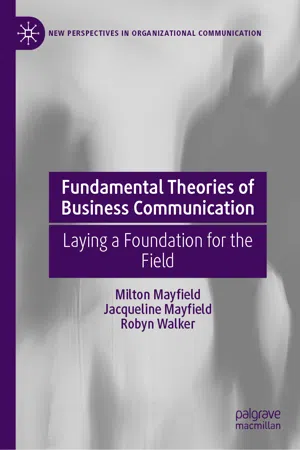Choosing the Right Communication Channel
Choosing the right communication channel involves selecting the most effective method for sharing information within an organization. Factors to consider include the nature of the message, the audience, and the desired level of interaction. Common channels include email, phone calls, video conferencing, and in-person meetings, each with its own advantages and limitations.
8 Key excerpts on "Choosing the Right Communication Channel"
- eBook - ePub
Solutions
Business Problem Solving
- Frank Fletcher, Eric Bolland, Eric Bolland(Authors)
- 2016(Publication Date)
- Routledge(Publisher)
...Body language, posture, eye contact, and facial expressions clue receivers to the subconscious thoughts of the sender. For example, managers who use good posture, appear relaxed but confident, make good eye contact, and smile occasionally, appear to be authoritative and sincere. It is important for written, verbal and nonverbal messages to be consistent and harmonious. Listening to a concert with one of the choir members singing off key detracts from the experience. Similarly, the message can get lost if the sender’s written, verbal, and nonverbal signals are dissonant. For example, if the sales manager’s written message introduces a new service line, but his voice and nonverbal communication suggests doubt about its potential, the sales force may come away from the meeting less than motivated. The resulting impact of incongruent messages may be disastrous for the company. What are the channels of business communication? Business messages are distributed through communications channels or media. Development of information technologies in recent years has given managers more channel options than ever before. Channels have unique characteristics that meet specific communications needs. For example, interpersonal communication offers more opportunities for face-to-face exchange, while web-based channels allow communication en masse—with potentially millions of people all over the world. Selection of appropriate channels is driven by the purpose of the communication and the size and needs of the organization. Face-to-face interactions provide the best channels for interpersonal communications. These types of interactions may be one-to-one, in small or large group settings, via the telephone, or over the Internet in the form of video-conferencing. Effective interpersonal communications are best achieved in one-to-one or small group settings...
- eBook - ePub
- Phil Jones(Author)
- 2017(Publication Date)
- Gower(Publisher)
...Whether this was first initiated by the French management, the local management or the unions and workers is unclear. The closures did not affect the French plants. This led to some suggestions that inefficient French plants were being saved by sacrificing the British plants. 3 The important thing is to be conscious that these tensions exist. That way you can explain why you were unable to communicate them beforehand. Channels and Their Effectiveness At the start of this chapter we had the example of an organization that created a communication strategy by documenting the communications channels it currently had. In contrast, we have concentrated on: Who is important in this strategy? What response do you want? What do they need to know? What are the real connections? When do they need to know? How do we get to these people? What channels exist already and how effective they are? The purpose of your communication channels is to get to as many of your targets, as reliably and quickly as possible and get maximum feedback. So in choosing the channels, there are six main criteria. These are: Does it provide feedback or is it one way? Is it reliable? Can I control the message that passes through it? Can I communicate a rich message or only a simple one? Will it go to many people or only a few (broadcast or narrowcast)? Will it be a personal or an impersonal message? How long does it take to prepare? How long does it take to communicate, once it is ready? The channels split into three main groups. Face-to-face communication channels rely on a personal contact. They include individual meetings, team meetings, large gatherings and conferences, as well as the informal networks. Electronic channels provide a powerful way to get a message out quickly. They include email, phone, messaging, blogging, message boards and discussion forums...
- eBook - ePub
Communicating for Managerial Effectiveness
Challenges | Strategies | Solutions
- Phillip G. Clampitt(Author)
- 2016(Publication Date)
- SAGE Publications, Inc(Publisher)
...From the users’ perspective, free TV entertains us, free e-mail links us, and free social networking connects us. From the providers’ perspective, not-so-free TV garners lots of eyeballs, not-so-free e-mail hooks us into a network, and not-so-free social networking generates overflowing cascades of data to exploit. The same principle holds when looking at different levels of an organization. That is one of the strategic implications explored in the next section. What to Do? Consider all the ways in which a typical employee can communicate today: memo, e-mail, blogs, phone call, microblog, Facebook, text message, bulletin board, websites, voice mail, and PowerPoint, to name the most familiar. With this bewildering array of options, many managers are tempted to just spin the wheel and select a channel. In fact, the sender’s personal convenience guides most channel selections. Further compounding the challenge is the fact that as a communication technology’s ease of use increases (e.g., lower costs), so does the likelihood of use, enticing us into making thoughtless choices. Few employees consider how their channel selections generate unique benefits and costs. The channel or technology necessarily alters the messages, just as the composition of an electrical wire affects the flow of electricity. Some scholars, for example, claim that the phonograph changed classical musicians’ technique and that MP3 players have ruined pop music. 27 French intellectuals grouse that text messaging has corrupted their language. 28 In short, channels accentuate certain attributes of the message while de-emphasizing others. Channels shape, contort, and distort messages even as they imperceptibly transform senders and receivers. Of course, recognizing that channels alter messages in important ways does not equate with knowing how to select the right strategies to achieve organizational goals...
- Institute of Leadership & Management(Author)
- 2013(Publication Date)
- Routledge(Publisher)
...to correspond to it to be right, for there is no right answer applicable to all situations. But what you do need to do is choose the right communication channel objectively for a particular purpose, weighing the pros and cons of each before automatically picking up the phone, sending an email, calling a team briefing – whatever your instinctive preference may be. Activity 19 Look at the following six practical situations and state what you believe would be the right solution to the communication problems they pose. 1 One of your delivery vehicles has had an accident and you need to advise customers that their deliveries will be affected. 2 You are working on a new quality manual and your boss wants to eliminate as much paper as possible. 3 You need to send a complicated draft mortgage offer to a client. 4 You need to bring your team up-to-date concerning three serious near misses which have happened recently. 5 You need to check if seven people from other sites and departments can attend a sales meeting in three days’ time. 6 Contractors’ employees have been using the staff restaurant and cloakrooms without authorization. You will find a series of suggestions on page 63, with a short explanation of why they were chosen. No doubt your own recommendations range widely, as mine do, across the available channels, to suit the needs of the situation you are in. Though your answers may differ to some extent, what really matters is the decision-making process which you have gone through, based on the activities in this session,...
- eBook - ePub
Successful Employee Communications
A Practitioner's Guide to Tools, Models and Best Practice for Internal Communication
- Sue Dewhurst, Liam FitzPatrick(Authors)
- 2022(Publication Date)
- Kogan Page(Publisher)
...06 Choosing channels for employee communication Finding inspiration from others CHAPTER OBJECTIVES Communications pioneer Bill Quirke (1995) was talking about the importance of outcomes over outputs a few decades ago. It goes to show that many aspects of good communication practice stand the test of time. What has changed is the channels landscape. Thanks to technology, we’re working in a golden age of possibilities. We can cross geographies and time zones, reach people working remotely, and invite anyone and everyone to create content, join conversations, form communities and collaborate. We can even cope when a global pandemic turns our organizations upside down – scattering teams, emptying offices and cutting off face-to-face contact. The question we’re most often asked in this area is ‘What are other people doing?’ So, this chapter is a small smorgasbord of case studies. We don’t suggest you copy someone else’s channels mix – their organization is not your organization. But we’ve highlighted some thinking points along the way. Throughout this book we’ve emphasized outcomes, not outputs. ‘Are channels not outputs?’ you may ask. Indeed they are. And very important they are, too. Channels are your shop window, the visible face of the communications team for most people in the organization. If you don’t have the right channels infrastructure, communication is likely to be a frustrating, inadequate experience. And if you choose the wrong tactics, it doesn’t matter how perfectly you word the objectives of your comms plans – you won’t achieve them. Our point is that outputs are a means to an end, not an end in themselves. Communicators shouldn’t just have great channels. They should deliver results and help things happen through great channels. Why every organization needs a good toolbox When Liam was growing up, the only tools in the family home were a hammer, a screwdriver and a funny pointy thing to make holes in leather...
- eBook - ePub
Managing Service Excellence
The Ultimate Guide to Building and Maintaining a Customer-Centric Organization
- C. William Crutcher(Author)
- 2017(Publication Date)
- Diamin Publishing(Publisher)
...This is how we discover our similarities, differences and, in the case of customers, how to better serve. 5. Admonish or Correct: Sometimes, despite best intentions and well-developed plans, others do not behave as expected. Here, we communicate both to attempt to fix the situation and to convey the consequences of similar future actions. Parents do this with their children when they declare a “time-out.” In business, admonishment might take the form of a stern lecture or disciplinary letter, accompanied by the real or potential consequences of such action. So which of these five purposes applies to more than 50 percent of human communication? We might immediately think that number 1—to share information—is the obvious answer. In reality, we spend the majority of human communication on number 4—building relationships. Though it might come in smaller, briefer segments, learning about others and sharing about ourselves is at the heart of most conversations. From a customer service perspective, this means learning about our customer so we can serve them better. INTERPERSONAL COMMUNICATION PROCESS What are the mechanics of communication? Diagram 4-1 illustrates the process we follow in communicating with one another. • Sender: Someone initiates the communication. The sender is the person who begins the process, and they determine who will be the receiver(s) of the communication. • Encode: The sender converts their thoughts into a message, conveying what the sender wants to communicate. This could be oral, written or expressive, such as a picture. • Medium: The sender chooses what modality to employ to transmit the message to the receiver(s). If the message is in oral form, the medium could be electronic—e.g., a phone call—or a face-to-face conversation. If the message is in written form, it could be delivered in hardcopy or electronically, such as an email. • Receiver: This is the intended recipient of the sender’s message...
- eBook - ePub
Managing Stakeholders as Clients
Sponsorship, Partnership, Leadership and Citizenship
- Mario Henrique Trentim(Author)
- 2015(Publication Date)
- Project Management Institute(Publisher)
...CHAPTER 8 There are no secrets to success. It is the result of preparation, hard work, and learning from failure. — Colin Powell B UILDING A S OLID C OMMUNICATIONS P LAN 8.1 The Communications Problem Communication is not enough. You have to share and transfer information. Communications are usually reports, meetings, and e-mails, or something else. Project managers gather information they need to manage, monitor, and control the project. Then they identify stakeholders that need that information and send it to them. What is the problem with this approach? Communicating is not throwing data, words, and reports to stakeholders or simply providing stakeholders easy access to information via software. This is a pushing approach; we feed stakeholders with information we want them to know. And that's a big mistake that results in poor communication. Miscommunication is the norm in many organizations. It is not different in project management (Stacey, 2000, quoted in Appelo, 2011). There are many surveys connecting poor communications to project failure. Some of them concluded that communication's problems are the main cause of project failure (IT Cortex, n.d.). Communicating is difficult because it involves encoding and decoding, which are impacted by personal filters and perceptions, as highlighted in Figure 8-1. When I say something, you can understand another thing because of your background, preferences, and more. Moreover, there are two other problems: noise and channel. Which channel we choose can influence how information will be accepted. For example, a message sent from formal channels is different from the same message communicated in an informal talk. Traditional communication processes, sometimes, don't include feedback. That is, the sender (or source) pushes information to the receiver without caring about how it's getting there and how it's going to be decoded, or understood...
- eBook - ePub
Fundamental Theories of Business Communication
Laying a Foundation for the Field
- Milton Mayfield, Jacqueline Mayfield, Robyn Walker(Authors)
- 2020(Publication Date)
- Palgrave Macmillan(Publisher)
...© The Author(s) 2020 M. Mayfield et al. Fundamental Theories of Business Communication New Perspectives in Organizational Communication https://doi.org/10.1007/978-3-030-57741-4_5 Begin Abstract 5. Channels and Barriers Milton Mayfield 1, Jacqueline Mayfield 1 and Robyn Walker 2 (1) Texas A&M International University, Laredo, TX, USA (2) Marshall School of Business, University of Southern California, Los Angeles, CA, USA Jacqueline Mayfield Email: [email protected] Keywords Barriers Business communication Channels Descriptions Theory End Abstract Something there is that doesn’t love a wall —Robert Frost, Mending Wall Chapter Theories Business English as a Lingua Franca Communication Apprehension Communication Competence Genderlect Theory Information Theories Media Naturalness Media Richness Theory Media Synchronicity Theory Multimodality Social Presence Theory Source Credibility Uncertainty Reduction/ Initial Interaction Theory We should value clear messages in any business. communication. By clarity, we mean transparency, or “sharing [all] genuine information that is relevant to an employee’s work in a timely manner” (J. Mayfield & Mayfield, 2018c, p. 52). Transparency leads to increased engagement, workplace trust, organizational commitment, and perceived leader effectiveness (Holmes & Parker, 2017 ; J. Mayfield & Mayfield, 2018c ; Norman, Avolio, & Luthans, 2010). Just as important, clear business communication matters because it is ethical. We will discuss this impact in more detail later in this introduction. Theories in this category reap the advantages of transparency by giving us the tools to understand and examine the barriers to clear communication and the channels through which communication (clear or not) travels. Plus, these same theories explore the bedrock requirements of communication—how to send a message...

